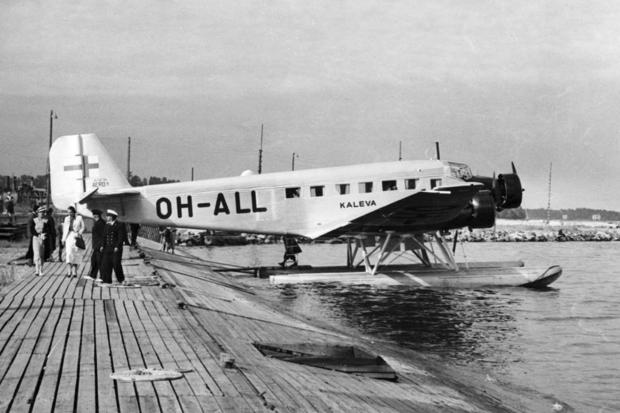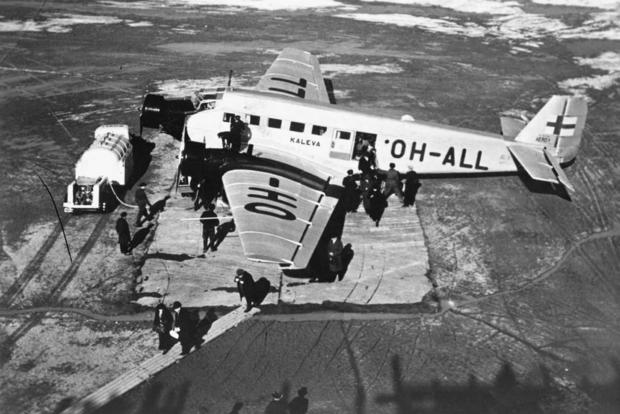
Remains of WWII-era plane carrying U.S. diplomat and downed by Soviet bombers found by divers
A World War II-era mystery surrounding the disappearance of a Finnish passenger plane carrying American and French diplomatic couriers that was shot down over the Baltic Sea appears to have been solved more than eight decades later.
The plane was en route from Tallinn to Helsinki when it was downed by Soviet bombers on June 14, 1940 – just three months after Finland signed a peace treaty with Moscow following the 1939-40 Winter War. It was also days before Moscow annexed the Baltic states.
/ AP
All nine people on board – a two-member Finnish crew and seven passengers – were killed.
shared a post on X that included photos of Antheil, Kaleva and a memorial plaque by the American Foreign Service Association in Washington with Antheil’s name engraved in it.
Finnish Aviation Museum via AP
Kaleva was carrying 227 kilograms (500 pounds) of diplomatic post, including Antheil’s pouches and material from two French diplomatic couriers — identified as Paul Longuet and Frederic Marty.
Estonian fishermen and the lighthouse operator on Keri told Finnish media decades after the downing of the plane that a Soviet submarine surfaced close to Kaleva’s crash site and retrieved floating debris, including document pouches, that had been collected by fishermen from the site.
This has led to conspiracy theories regarding the contents of the pouches and Moscow’s decision to shoot down the plane. It still remains unclear why precisely the Soviet Union decided to down a civilian Finnish passenger plane during peacetime.
“Lots of speculation on the plane’s cargo has been heard over the years,” Geust said. “What was the plane transporting? Many suggest Moscow wanted to prevent sensitive material and documents from exiting Estonia.”
But he said that it could have simply been “a mistake” by the Soviet bomber pilots.
Finding the wreckage
Various attempts to find Kaleva have been recorded since Estonia regained independence more than three decades ago. However, none of them have been successful.
Not even the U.S. Navy’s oceanographic survey vessel Pathfinder could locate remains of the plane in a 2008 search around the Keri island in a venture commissioned by the Estonian government from the Pentagon.
“The wreckage is in pieces and the seabed is quite challenging with rock formations, valleys and hills. It’s very easy to miss” small parts and debris from the aircraft, Peremees said. “Techniques have, of course, evolved a lot over the time. As always, you can have good technology but be out of luck.”
New video taken by underwater robots from Peremees’ company show clear images of the three-engine Junkers’ landing gear, one of the motors and parts of the wings.
Peremees and his group are “absolutely” convinced the parts belong to Kaleva because of the distinctive and recognizable design of the German-made Junkers Ju 52, one of the most popular European passenger and wartime transport planes in the 1930s and early 1940s.
Finnish Aviation Museum via AP
The plane was operated by the predecessor of the Finnish national airline Finnair.
Jaakko Schildt, chief operations officer of Finnair, described Kaleva’s downing as “a tragic and profoundly sad event for the young airline” that Finnair, then named Aero, was in 1940.
“Finding the wreckage of Kaleva in a way brings closure to this, even though it does not bring back the lives of our customers and crew that were lost,” Schildt said. “The interest towards locating Kaleva in the Baltic Sea speaks of the importance this tragic event has in the aviation history of our region.”
Peremees said his company would now focus on creating 3D images of Kaleva’s debris and discuss with Estonian authorities about the possibility of raising some of the items and, if found, the plane’s cargo and human remains.
Snyder from the U.S. Embassy in Tallinn said that Washington is closely monitoring the diving group’s efforts.
“We are following the investigation of the site and will be happy to discuss with our Finnish and Estonian (NATO) allies any developments resulting from recovery efforts,” Snyder said.
A stone memorial set up in the early 1990s to the victims of the Kaleva crash is located on Keri, and Helsinki’s old preserved Malmi airport terminal building, where Kaleva was supposed to arrive, has a memorial plaque set up in 2020 with the names of the victims.
Raw video: Wreck of German WWII ship found in Baltic Sea
00:44
Source: cbsnews.com

